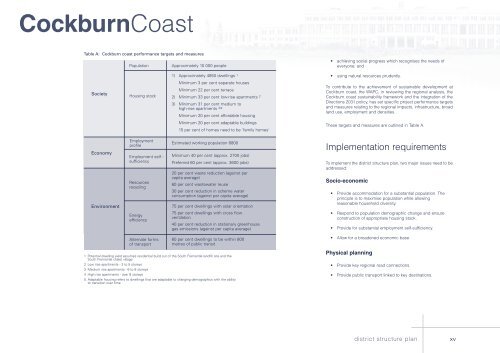CockburnCoast - Western Australian Planning Commission
CockburnCoast - Western Australian Planning Commission
CockburnCoast - Western Australian Planning Commission
Create successful ePaper yourself
Turn your PDF publications into a flip-book with our unique Google optimized e-Paper software.
<strong>CockburnCoast</strong><br />
Table A: Cockburn coast performance targets and measures<br />
Population<br />
Approximately 10 000 people<br />
• achieving social progress which recognises the needs of<br />
everyone; and<br />
1) Approximately 4850 dwellings 1<br />
• using natural resources prudently.<br />
Society<br />
Housing stock<br />
Minimum 3 per cent separate houses<br />
Minimum 22 per cent terrace<br />
2) Minimum 33 per cent low-rise apartments 2<br />
3) Minimum 31 per cent medium to<br />
high-rise apartments 3/4<br />
Minimum 20 per cent affordable housing<br />
To contribute to the achievement of sustainable development at<br />
Cockburn coast, the WAPC, in reviewing the regional analysis, the<br />
Cockburn coast sustainability framework and the integration of the<br />
Directions 2031 policy, has set specific project performance targets<br />
and measures relating to the regional impacts, infrastructure, broad<br />
land use, employment and densities.<br />
Minimum 20 per cent adaptable buildings<br />
15 per cent of homes need to be 'family homes'<br />
These targets and measures are outlined in Table A.<br />
Economy<br />
Environment<br />
Employment<br />
profile<br />
Employment self -<br />
sufficiency<br />
Resources<br />
recycling<br />
Estimated working population 6800<br />
Minimum 40 per cent (approx. 2700 jobs)<br />
Preferred 60 per cent (approx. 3600 jobs)<br />
20 per cent waste reduction (against per<br />
capita average)<br />
60 per cent wastewater reuse<br />
30 per cent reduction in scheme water<br />
consumption (against per capita average)<br />
75 per cent dwellings with solar orientation<br />
Implementation requirements<br />
To implement the district structure plan, two major issues need to be<br />
addressed:<br />
Socio-economic<br />
• Provide accommodation for a substantial population. The<br />
principle is to maximise population while allowing<br />
reasonable household diversity.<br />
Energy<br />
efficiency<br />
75 per cent dwellings with cross flow<br />
ventilation<br />
40 per cent reduction in stationary greenhouse<br />
gas emissions (against per capita average)<br />
• Respond to population demographic change and ensure<br />
construction of appropriate housing stock.<br />
• Provide for substantial employment self-sufficiency.<br />
Alternate forms<br />
of transport<br />
60 per cent dwellings to be within 800<br />
metres of public transit<br />
• Allow for a broadened economic base.<br />
1 Potential dwelling yield assumes residential build out of the South Fremantle landfill site and the<br />
South Fremantle chalet village<br />
2 Low rise apartments - 3 to 5 storeys<br />
3 Medium rise apartments - 6 to 8 storeys<br />
4 High rise apartments - over 8 storeys<br />
5. Adaptable housing refers to dwellings that are adaptable to changing demographics with the ability<br />
to transition over time<br />
Physical planning<br />
• Provide key regional road connections.<br />
• Provide public transport linked to key destinations.<br />
district structure plan<br />
xv

















